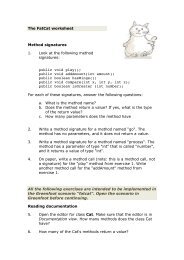SCIENCE TEST
SCIENCE TEST
SCIENCE TEST
You also want an ePaper? Increase the reach of your titles
YUMPU automatically turns print PDFs into web optimized ePapers that Google loves.
when they reach the core boundary. The p-waves go through the boundary and bend. In<br />
Passage I, we are told that “Figure 1 shows how p-waves and s-waves move and are<br />
refracted (bent) as they travel through different layers of Earth’s interior.” This tells us<br />
that “refracted” means “bent”. So the p-waves are refracted when they enter the core.<br />
3. Based on Figure 3, for a given seismograph, the time elapsed between the arrival of the first p-waves and<br />
the arrival of the first s-waves from an earthquake focus 10,500 km away would most likely be:<br />
A. less than 5 min.<br />
B. between 5 min and 7 min.<br />
C. between 8 min and 10 min.<br />
D. more than 10 min.<br />
Answer: D.<br />
In Figure 3, the horizontal axis of the graph shows “distance along Earth’s surface<br />
from earthquake focus to seismograph (km)”. The vertical axis shows “time to reach<br />
seismograph from earthquake focus (min)”. So the time elapsed between the arrival<br />
of the first p-‐waves and the first s-‐waves at a given distance is the vertical difference<br />
between the lines at that distance. For example, at 2,000 km, it takes 7 minutes for<br />
the first s-‐waves to reach the seismograph, and 4 minutes for the first p-‐waves. The<br />
time elapsed is 7-‐4 = 3 minutes. At 3,000 km, the time elapsed is 10-‐6 = 4 minutes.<br />
Since 10,500 km is not on the graph, we have to guess. We see that the distance<br />
between the s-‐wave and p-‐wave curves (time elapsed) is getting bigger. At 9,000<br />
km, the distance between the curves is about 22-‐11 = 11 minutes. At 10,000 km, we<br />
can’t tell exactly since the s-‐wave curve is already past 23 minutes, but it looks like<br />
the distance between the curves continues to grow. We expect that at 10,500 km the<br />
distance will be even greater, so time elapsed is probably greater than 11 minutes.<br />
This makes D the best answer.<br />
4. Based on the information provided, the “time earthquake starts at the focus” in Figure 2 corresponds to<br />
which of the following points on Figure 3?<br />
F. 0km,0min<br />
G. 2,000 km, 5 min<br />
H. 5,000 km, 12 min.<br />
J. 10,000 km, 20 min<br />
Answer: F.<br />
We are looking for the point on Figure 3 that represents the “time earthquake starts<br />
at focus”. The seismograph is at the earthquake focus when it is 0 km from the focus.<br />
The time 0 min marks the start of the earthquake. So the “time earthquake starts at<br />
focus” is represented by the point 0 km, 0 min (bottom left corner) on Figure 3.<br />
5. According to Figure 2, which of the following statements best describes the relative amplitudes of the<br />
first p-waves to arrive at the seismograph and the first s-waves to arrive at the seismograph? The amplitude<br />
of the first p-waves to arrive at the seismograph is:<br />
A. smaller than the amplitude of the first s-waves to arrive at the seismograph.<br />
B. larger than the amplitude of the first s-waves to arrive at the seismograph.



